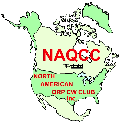
 | NAQCC News |
| Jan 31, 2009 | NAQCC Web Site | Issue #087 | |
|---|---|---|---|
| In this issue: 1. February Challenge. 2. January Sprint Results 3. General Club News 3a. KX-1 Project 4. Elmer Project 5. Latest Award Winners 6. News Items and Articles by Our Members |
| 1. FEBRUARY CHALLENGE: As we do every February, we have a challenge dealing with the Presidents because it is the birth month of three of the greatest Presidents - George Washington, Abraham Lincoln, and Ronald Reagan. This year we're honoring the First Ladies. It's a standard alphabet type challenge with the words being the first names of several of the First Ladies through the years. A prize comes with this month's challenge in addition to certificates to the two members making the most names. The prize is a "Ladder Grabber" which is a device that makes it easy to connect ladder line to your antenna. It's donated by Emtech of Tracyton, WA. Thank you, Emtech. In case of ties, we'll resort to some sort of tie-breaker to be chosen later. Full Challenge info here. 2. JANUARY SPRINT RESULTS: 80M decided to behave quite well this month in a large part of the country although there were still a few areas that acted as 'black holes'. Often the good and bad areas were quite close. Here in Western PA, I (K3WWP) had it great, but stations 40-70 miles to the NE and SW complained about poor conditions. We received 56 logs this month, up a bit from the past couple months, but still below record numbers. STATS - current month, previous month, all time record, mo/yr (blue indicates a record set this month): Jan Dec Rec Month Logs - 56 50 64 9/08 Autologger logs - 49 45 57 9/08 Stns in logs - 86 81 110 5/08 Hour 1 QSO's - 343 177 564 9/08 Hour 2 QSO's - 255 160 476 9/08 Total QSO's - 598 337 1040 9/08 20M QSO's - 2 4 185 6/08 40M QSO's - 130 71 709 9/08 80M QSO's - 465 262 481 12/07WINNERS: 1st SWA East - K2UFT 1st SWA Central - W5AG 1st SWA Mountain - W0JFR 1st SWA Pacific - K6CSL 1st Gain - KB2OC Special Award (making a personal best all-time sprint score) Drawing Entrants: W2SH, W5AG, KB2OC Drawing Winner: W2SH Congratulations to all including winners and non-winners. Actually everyone who participated and sent in a log is a winner because that shows the ham radio world that there are many folks still using and enjoying CW on the ham bands. That's one of our main goals here at the NAQCC. Very special thanks to those who reported their results even though they made only a few QSO's. Your reports are important also. We had 6 stations who didn't submit a log show up 5-15 times in the 56 logs we received and cross-checked. Hopefully those 6 and many others will be back next month AND submit a log. Remember submitting a log doubles the strength of your statement that you support CW operation. We welcome these hams who submitted a sprint log for the first time. We hope they will continue to participate and report their results: K1NNJ, K2UFT, K4DXV, KB2OC, KB8TT, KC9BSP, KJ4FDV, N5MCI, W3IK And of course we had our special annual 160M sprint this month. Results are just final and the winners are: 1st - KD2MX 2nd - W2SH Looks like NJ had the best conditions on 160 that evening. Full sprint info here. 3. GENERAL CLUB NEWS: We're proud of those figures especially since the A-1 Op award is not solicited nor pre-arranged. It is more or less done by secret ballot in which a person is nominated completely independently by two existing A-1 Ops without the nominee knowing anything about it. When the ARRL receives the two independent nominations and matches them up, the nominee is notified he is now an A-1 Op and sent a handsome certificate hopefully to his complete surprise. I can remember how thrilled and surprised I was when I became an A-1 Op way back in the 1960's. K3WWP - 7 (ineligible) N9AKF - 1 K0TRL - 1 W9ILF - 1 W0EJ - 1 Obviously it is wide open right now with K3WWP not being eligible, so get out there and recruit, recruit, recruit. Win one for the Gipper.....oh no, that's another locker room speech. HI 3a. KX-1 PROJECT: 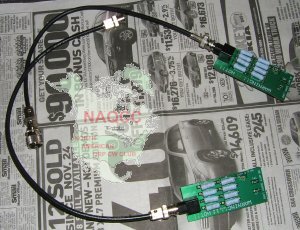 Before we started on the main KX-1 board, we made up a couple cables for the dummy loads we constructed previously. Neither of us had used solderless BNC connectors before, and were very impressed with the ease of installing them on coax. One note of caution though - don't overtighten the screw that makes contact with the coax shield as that can lead to a short between the shield and center conductor. Before we started on the main KX-1 board, we made up a couple cables for the dummy loads we constructed previously. Neither of us had used solderless BNC connectors before, and were very impressed with the ease of installing them on coax. One note of caution though - don't overtighten the screw that makes contact with the coax shield as that can lead to a short between the shield and center conductor.Most of the work went pretty much straightforward. If you decide to build a KX-1 or any kit for that matter, always be sure to follow the assembly manual exactly. It may seem illogical at times to do some things in a certain way, but there is rhyme and reason behind everything in that manual. If some section of a manual involves several steps in installing a component, but sure to read and understand all the steps before doing anything with that component. 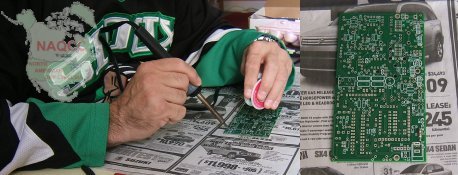 Here's Mike making the ceremonial first solder connection on the main KX-1 board and the result - the resistor in the lower right corner. There are a few surface mount components that are pre-installed on the board. Here's Mike making the ceremonial first solder connection on the main KX-1 board and the result - the resistor in the lower right corner. There are a few surface mount components that are pre-installed on the board.A couple members expressed concern that we weren't doing enough to prevent static damage to sensitive parts. While not apparent from the photos, the card tables we are working on have a metal frame that acts as a very good ground as we are in contact with it most of the time. When we get to an extra sensitive part, we also touch the frame several times while working with it as an extra precaution. Let's talk a bit about some things specific to the KX-1 kit, then a couple more general tips. The KX-1 comes with two 68pf caps. If the two are different sizes, be sure to install the correct one in the correct place. When you run into the installation of the first 68pf cap, read that step carefully. If you gloss over it, it's easy to use the wrong one. The smaller one fits in a very cramped tiny space. If one of yours is bigger, it won't fit there. When you get to mounting the antenna jack J2, it requires a lot of heat because the metal frame of the jack acts as a heat sink. The manual recommends using a higher wattage soldering iron for the jack, but Mike and I found that using 2 smaller irons on the pin simultaneously also works very well. With just the center pin of J2 soldered, it's a good time to 'dry fit' the board into the case. That allows you to re-position J2 slightly if it doesn't exactly fit into the round hole of the case before you make the final 2 connections - the ones that require the extra heat. Once they are soldered, it is hard to desolder and adjust. The dry fit also allows you to see if any parts are mounted too high on the board. Real estate is at a premium in the KX-1, and if a part sticks up from the board too far, it won't go in the case properly. That is stressed consistently throughout the manual. We did find one cap that was too high. We had to de-solder it, adjust its leads, and push it closer to the board.  Always have a very good solder sucker while building the KX-1 or any kit. One of the easiest ways to damage a PC board is de-soldering and re-soldering a connection. A good solder sucker allows the process to take place quickly without overheating the board. This is one that was given to me by Tom WY3H about a year ago. It's the best one I've ever used. Always have a very good solder sucker while building the KX-1 or any kit. One of the easiest ways to damage a PC board is de-soldering and re-soldering a connection. A good solder sucker allows the process to take place quickly without overheating the board. This is one that was given to me by Tom WY3H about a year ago. It's the best one I've ever used.One other general tip that may be obvious is to use a heat sink if you happen to be soldering a temperature sensitive component with a long enough lead to be able to use one. With PC board kits, most component leads are too short for this, so the solder connection must be made as quickly as possible. However if you do need a good heat sink, one can be quickly improvised by using needle nose pliers with a rubber band to hold them closed like a clamp. 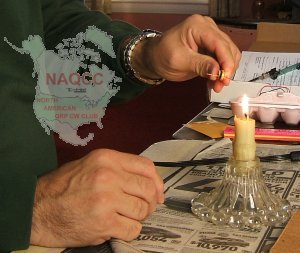 In winding the toroids, there are three ways suggested in the manual for removing the enamel from the wire - heat, solder, and scraping. We found the heat method to work best. Mike came up with a great way of applying that heat. Use a candle in a candlestick holder. It more or less adds an extra hand to the process since it is a stable source of heat rather than trying to hold a lighter or a match. In winding the toroids, there are three ways suggested in the manual for removing the enamel from the wire - heat, solder, and scraping. We found the heat method to work best. Mike came up with a great way of applying that heat. Use a candle in a candlestick holder. It more or less adds an extra hand to the process since it is a stable source of heat rather than trying to hold a lighter or a match.After a couple hours of careful, learning assembly, we arrived at the first 'alignment and testing' section of the manual for the display and microprocessor section of the rig. So far, so good as you see here with the LED display working as it should and no smoke pouring from the circuit board. 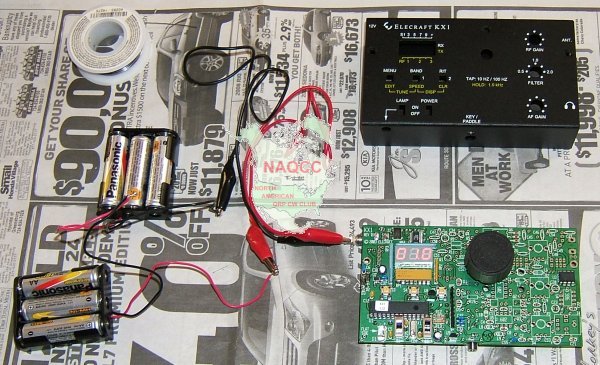 After using the batteries as a power source, we found a 12 volt power cube in my junk box and used that from then on. After working on the kit 3 days during the week (Tue, Wed, Thu), Mike returned on Sunday for a little more work. At the end of our Thursday session, we had trouble tuning the tiny trimmer caps on the board for lack of a proper tool. Mike brought a couple tools with him this day, but we finally wound up just winding some electrical tape around a regular miniature screwdriver. Another problem was that we hadn't turned the filter pot up all the way. As soon as we did that, the peaks in noise were much easier to find. The one 20M trimmer cap does have a very broad peak and it was hard to find the exact center of the peak by ear. 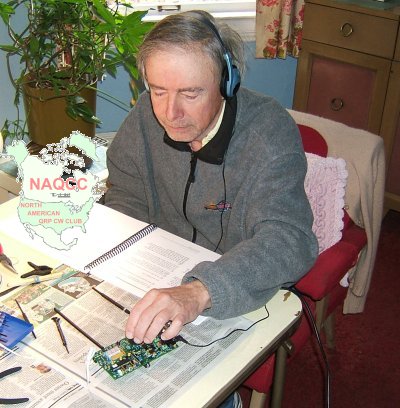 At any rate we did get the trimmers adjusted, hooked up a mobile whip that Mike brought and tuned around the band. All of a sudden 40M lost its noise and I was hearing CW signals! It took us a bit to realize that the noise we were hearing was being generated my microprocessor controlled furnace, and the signals appeared when the furnace heating cycle ended. 40M was full of signals, some quite strong. That was a relief and somewhat exciting to know at least the receiver section of the kit seemed to be working in fine shape. You can see John very absorbed in tuning around in this picture Mike took unexpectedly. I believe the actual first signal we heard was K4EJQ around 7.040. At any rate we did get the trimmers adjusted, hooked up a mobile whip that Mike brought and tuned around the band. All of a sudden 40M lost its noise and I was hearing CW signals! It took us a bit to realize that the noise we were hearing was being generated my microprocessor controlled furnace, and the signals appeared when the furnace heating cycle ended. 40M was full of signals, some quite strong. That was a relief and somewhat exciting to know at least the receiver section of the kit seemed to be working in fine shape. You can see John very absorbed in tuning around in this picture Mike took unexpectedly. I believe the actual first signal we heard was K4EJQ around 7.040.Now that the microprocessor and receiver circuits were assembled and working, we moved on to the transmitter section. As in the previous sections, assembly went smoothly for the most part thanks to the well written manual. Mike had to wind a toroid that had two separate windings on it. That was a little tricky, and while he was winding, I was thinking it was going to be a little difficult identifying which wire was which when he mounted it on the board. I thought leaving the 4 leads different lengths might work, so we made lead 1 the shortest and worked up to lead 4 being the longest. That worked very well. We were now at the final assembly steps and our first real major difficulty. Mounting the battery holders, while sounding like being an easy step, was quite a problem. The 2-56 screws supplied with the holders just weren't long enough to grip the threaded holes in the case. After trying and trying with no success, we raided my junk box of several hundreds (thousands?) of assorted screws and found a couple with the correct threads but longer. That worked well, but the screws will have to be cut off when Mike returns again. We couldn't get to the final testing of the rig because of the delay with the battery holders. Mike had to leave for a dinner engagement before we could do any testing. That was a bit frustrating for both of us, but couldn't be helped. Our next session will be on President's Day, February 16th when we should wrap up the main KX-1 kit and at least get started on the 8030 accessory board. Maybe even get it finished. Our next report will be in the end of February newsletter. NOTE - This series of KX-1 project articles and included pictures are the exclusive property of the NAQCC, and may not be copied in whole or in part by anyone. You may link to this entire newsletter if you wish, as long as the NAQCC is given full credit as the source of the information and pictures. 4. ELMER PROJECT: (by Karl N3IXR and Ron K5DUZ) - From Karl N3IJR #1770 - I just want to report that we did have a response to our cry for help with the CW Elmering Project. I want to thank Steve/NU7T, Paul/N0NBD, Tom/WY3H, Fred/KC8FS, and Bob,KG4UQA (student) for their response, Great! Well I know that I would not even be writing this if it was not for an Elmer. When I started out in Ham Radio, I did not even know where to begin. So I am glad that we now have a beginning for anyone who wants it. For the time being, if you want help just e-mail me at I wanted to share with you two free websites on learning CW, lcwo.net and www.justlearnmorsecode.com. Both are FREE and I have played around with both and they each seem pretty neat. When I got started I had to learn code to get my ticket and I used the ARRL code tapes to learn. I bought all three, from the 5 wpm to the 20 wpm. They worked really well for me. But here is the bottom line, if you want it you can have it! I had really wanted to learn Morse Code, I think that is the key. I would encourage all NAQCC members to be willing to HELP, when ever you can. I also suggest to listen to 7.114 mhz plus or minus a couple and see if you can find the slow code guys and give a hand. Lately I have been hanging out there and have had some neat QSO's. So please give it a try. It really is fun and helpful. That's it for now and thanks to all Elmers. Ham Radio is all about helping each other! 5. AWARD WINNERS THE PAST TWO MONTHS: KB3ONA - 1000MPW # 0045, 0046, 0047 KC2EGL - 1000MPW # 0048, 0049, 0050 N9AKF - 2XQRP 250 PTS # 0008 NU7T - AlphaPrefix USA - # 0006 2008 PARTICIPATION AWARDS: K3WWP - EASTERN NU7T - WESTERN VE3HUR - VE/DX W2JEK - FREE FISTS MEMBERSHIP K3WWP - 2008 QSO A DAY FULL YEAR NU7T - Suffix Words (any antenna) # 0001 K3WWP - Suffix Words (SWA) # 0001 N8XMS - Suffix Words (SWA) # 0002 Also some updates to our honor rolls WY3H - 2XQRP - 1000 points NU7T - AlphaPrefix USA - 112 K4PBY - AlphaPrefix USA - 104 NU7T - Suffix Words - 50 K3WWP - Suffix Words - 100 Interest in our awards continues to increase, and we're delighted. Awards are yet another way to show the continuing popularity of CW on the ham bands, and earning them with QRP shows the very high efficiency of CW. We now have a nice incentive to work towards and earn our NAQCC awards thanks to Gregg WB8LZG. We're sure you all know by now of our latest donation by Gregg of beautiful knob inserts for the K1 and K2 rigs. If you're not aware, check the Giveaways page in the main section of the web site for info and a picture. You can win one by earning and applying for any TWO of the following NAQCC awards. It's first come, first served, so make haste. QSO-A-DAY 30-30 Alphabet Prefix Worked Members - Advanced Suffix Words See the 'Current' page in the 'Awards' section of the web site for rules for these awards. Only new applicants on or after October 1, 2008 are eligible. Congrats go to Steve NU7T for being the very first winner of a knob insert by earning the AlphaPrefix and Suffix Words awards. Full List of all award winners here. 6. NEWS ITEMS AND ARTICLES BY OUR MEMBERS: This section is a forum for you to tell other members what you've been up to on the ham bands or to submit an article dealing with some aspect of CW and QRP operation or equipment. Send your news items and articles to our news editor Paul KD2MX at I nearly blew the January challenge. With so much to keep track of mentally, I forgot you needed 5 points to get a participation point for the challenge. While Mike KC2EGL was here working on the KX-1, we looked up the challenge rules for some reason, and I saw my 2 points wasn't going to get me my point. So on the 26th, I switched in my attenuator pad and made 3 quick rag chew type QSO's with 930 mW on 40M around Noon. It was so easy, I probably could have gotten many more QSO's during the month, but I just didn't have time. Yes, even at a sunspot minimum it is very easy to get non-contest QRPp QSO's. Even easier to get them at a full QRP gallon - 5 watts. Time has also kept me from seriously working on the FISTS Area Code award, but I have gathered about a dozen AC's so far this month, including some via my mW QSO's. Yes, you can rag chew at mW power. QRPp QSO's don't have to be just a quick exchange of signal reports. From everything I hear from our host in YN-land, my call should be YN2DD but if that does not happen I will be using H7/K8DD. In the past I have worked anywhere from a half dozen QRP stations to about 30. Normally I set the keyer between 18 and 26 WPM but if stations figure out it's me (and that always happens) and send their call slower I always try to match the speed of the station calling. So mark your calendars for February 19 Local / February 20 at 0230 GMT! First is the challenge of it. As I said, I am extremely right-handed, even just thinking about doing things with my left hand "feels" awkward. I can't yet match the speed and accuracy of my right hand but I am making progress. Secondly there is a physical reason. I developed some significant tendonitis in my right arm and hand while working on some home improvement projects over the summer. It impacted my CW only a little bit, and has mostly cleared up anyway, but the thought occurred to me of what would happen if it got worse. Finally, although I have been working CW since 1970, I have never used a bug and I would really like to give one a try. Some have told me that it can be hard to switch between a paddle and a bug so I thought that I would try to learn how to work my paddle with my left hand and a bug with my right. I don't even own a bug yet so I can't really say if this is going to work or not. The prices that I see for bugs have partly scared me off of this but I will probably eventually get one and give it a try. I'm getting ready to "go South" for a month and will be back around the first of March so there won't be any activity on the "blog" until I return. As you can tell, I'm a Morse Code promoter. I don't feel like I'm a real Ham until I put on the headphones and get the "key" in my hand. But I think it's also interesting (and encouraging) to note the camaraderie of "CW" operators. It's something I've found in NO other hobby. I had a QSO with another ham recently and jokingly mentioned I was using a $14.95 "bargain key". It worked perfectly (and I was happy using it). He then made the comment that he would send me a "real" one if my QRZ info was correct. When I received it the next week, I nearly fell over when I opened the package. The key was made sometime between 1880 and 1910. (it has a serial number stamped on the bottom). It was made by a New York Company called Brunell(sp?). This "straight key" is about 100 years old. I consider it priceless! The original version was made "totally" out of solid brass (even the center lever) but was "improved" with a "single forged" piece of steel (only the center lever) with the hopes it would "wear better". As you probably know, brass is fairly "soft". This is the key that I now proudly use every day I'm on the air. This ham knew exactly what it was (and the historical significance) but had come into possession of it thru the estate of a SK. He wishes to remain anonymous (and was VERY specific about that). He only asked that I write a nice "thank you" to the ham's wife, which I did immediately. He sent it to me FREE and postage paid, since those were the "terms" of the silent key. I will also pass this key along to another "deserving ham" in my very senior years, out of respect and admiration for this SK's love of the hobby! You won't find that kind of enthusiasm, passion, and respect these days for a mode of communications many people feel is a lost art. Personally, I think CW will be alive and well for many, many, good years! 72 |
| The publication of our next newsletter will be announced via email to all members for whom we have a valid email address unless you specifically have unsubscribed from the email. Past on-line newsletters beginning with issue #042 are now archived on the site. So if you missed seeing any past issues, you can check them out in the archives. Unless otherwise credited, all items are written by K3WWP. If you came directly to this newsletter, we invite you now to browse the NAQCC Web Site. |